Distinguishing Features: Has the Diversity of Brown-throated Parakeets Been Overlooked?
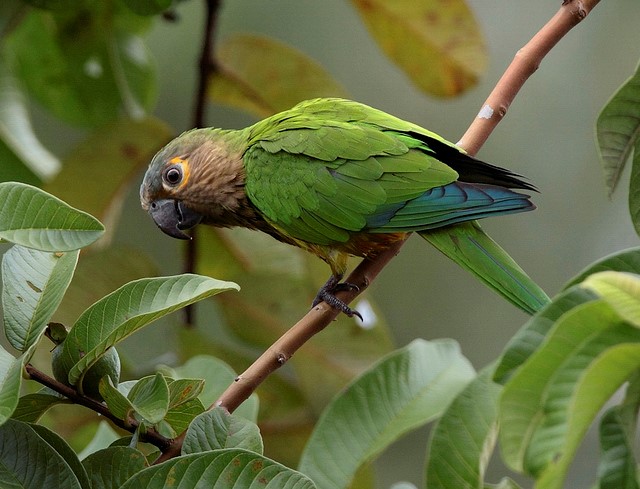
Brown-throated Parakeet, Eupsittula pertinax chrysophrys. (Boa Vista, Roraima, Brazil; July 30, 2012.) © Anselmo d’Affonseca
The Brown-throated Parakeet (Eupsittula pertinax), as traditionally classified, consists of fourteen subspecies: eight of which are spread across northern South America; one is isolated in southern Central America; and five are endemic to southerly Caribbean islands—Aruba, Curaçao, Bonaire, La Tortuga, and Margarita. Compared to the other Eupsittula parakeets, the Brown-throated is outwardly diverse. Most notably, its many populations vary both internally and amongst themselves in the coloration and patterns of their head plumage. Some are mostly grayish-brown and some are mostly yellow or orange, but the adults of most populations fall somewhere on a spectrum in between: predominantly grayish-brown face, throat, and chest, with yellow or orange around the eyes.
Despite such conspicuous variation, however, the Brown-throated Parakeet has generally been regarded as a single species. The only exception is that the lone Central American subspecies, ocularis, has sometimes been classified as a distinct form or separate species.
As detailed below, however, the Brown-throated Parakeet should arguably be subdivided into four distinct forms, each of which could potentially be recognized as a separate species:
“Yellow-headed Parakeet” (pertinax and xanthogenia) of Curaçao and Bonaire, which is readily distinguished by its predominantly yellow or orange face and throat.
“Gray-throated Parakeet” (aeruginosa—and griseipecta, if valid) of northern and central Colombia and the Maracaibo Basin of Venezuela, which has an entirely grayish-brown face and throat, and never shows any yellow or orange on the face.
“Veraguan Parakeet” (ocularis) of the Pacific slope of Central America from southern Costa Rica to central Panama, which has a predominantly grayish-brown face and throat, and an orange crescent under the eye.
“Brown-throated Parakeet” (chrysophrys plus lehmanni, arubensis, tortugensis, margaritensis, venezuelae, surinama, chrysogenys, and paraensis), of northern South America east of the Andes and Maracaibo Basin, plus Aruba, La Tortuga, and Margarita, which has a predominantly grayish-brown face and throat, with an orange eyering that sometimes extends onto the lores or cheeks.
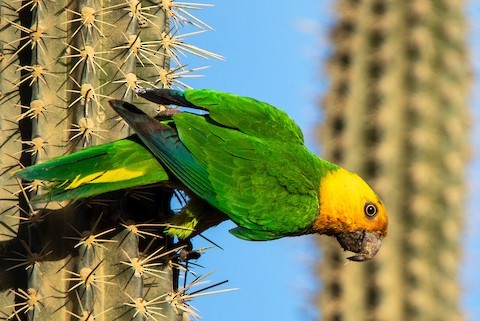
The Bonaire population of “Yellow-headed Parakeet” (xanthogenia) has a nearly all-yellow head. © Sandy & Bob Sipe
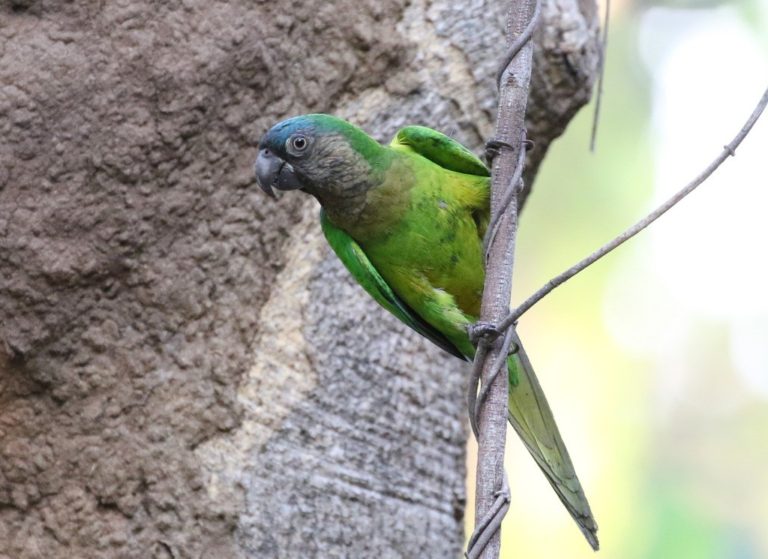
The “Gray-throated Parakeet” (aeruginosa) of northern and central Colombia differs from the others in having more blue on the forecrown and no yellow or orange on the face. © Matthew Grube

The Aruba population (arubensis) generally resembles the “Brown-throated” subspecies of northeastern South America. © Michiel Oversteegen

Despite its similarity to typical “Brown-throated” populations, the “Veraguan Parakeet” (ocularis) is the only subspecies that has often been regarded as a distinct form or potentially separate species. © Daniel Hernández
Although they appear readily distinguishable from the other populations of Brown-throated Parakeet, neither the “Yellow-headed” nor the “Gray-throated Parakeet” has been regarded as a potentially distinct form—at least, not in recent taxonomic references. For reasons that are not obvious, the only Brown-throated subspecies that has often been recognized as distinct is ocularis, the “Veraguan Parakeet” of southern Central America.
Following is an overview of the visible reasons for recognizing each of the three divergent localized forms as distinct from the widespread form (i.e., the remaining nine subspecies). Under this revised classification, the latter form could retain the name “Brown-throated Parakeet”, but its scientific name would be chrysophrys (under scientific naming conventions the oldest name has priority, and chrysophrys was the first of the nine “Brown-throated” subspecies to be described).
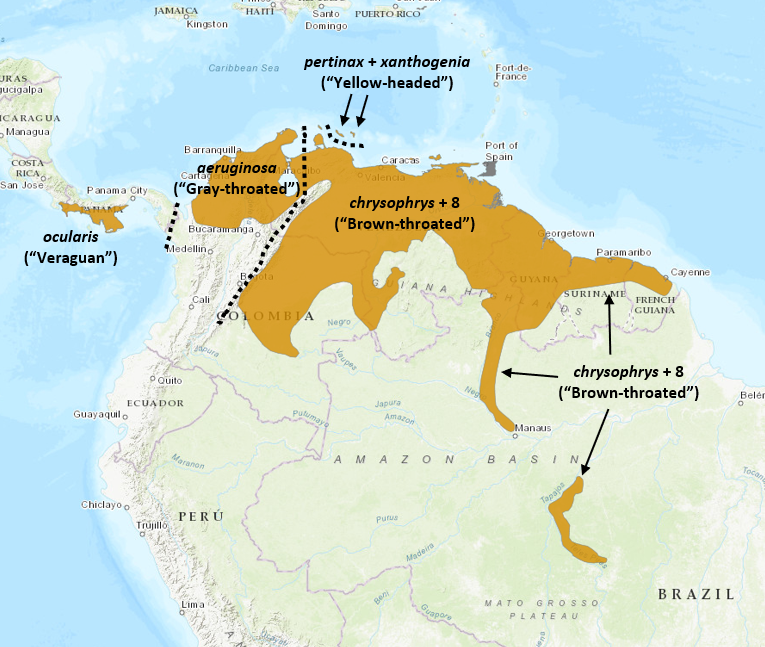
Approximate distributions of the four forms of Brown-throated Parakeet proposed here: “Yellow-headed” (pertinax) on Curaçao and Bonaire; “Gray-throated” (aeruginosa) in northern and central Colombia and westernmost Venezuela; “Veraguan” (ocularis) in southern Central America; and “Brown-throated” (chrysophrys) throughout much of northern South America east of the Andes and Maracaibo Basin, plus Aruba, La Tortuga, and Margarita. © BirdLife International 2018
“Yellow-headed Parakeet”. The subspecies pertinax and xanthogenia, of Curaçao and Bonaire respectively, differ conspicuously from other Brown-throated populations in having almost entirely yellow or orange heads. They differ slightly from one another in that the Bonaire birds’ heads tend to have more extensive and brighter yellow coloration than those of Curaçao, but the populations appear to overlap with one another in both pattern and coloration.
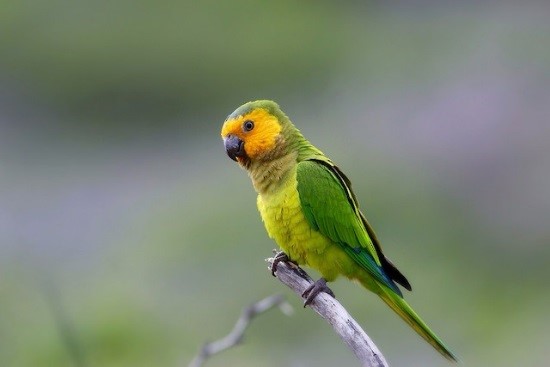
The Curaçao population of “Yellow-headed Parakeet” (pertinax) has a mostly yellow head with green on the crown. Anonymous eBirder

The Bonaire population of “Yellow-headed Parakeet” (xanthogenia) tends to have a yellower head with less green on the crown. © Sandy & Bob Sipe
Why does this striking, distinctive appearance not result in de facto recognition of the Bonaire and Curaçao populations as a separate species, or at least as a candidate to be considered as such? The reason seems to be obscure. It might be that the adjacent Aruba population (arubensis) sometimes shows extensive orange on its head, which could potentially blur the distinction between the yellow-headed populations of Bonaire and Curaçao and the plainer, brown-headed populations of the mainland. On some Aruban individuals, the orange appears very extensive, or the brown on the head seems tinged with orange, more so than in other “Brown-throated” populations. But despite these colorful outliers, the Aruban population’s coloration is much closer to that of the typical “Brown-throated” than it is to that of the Curaçao or Bonaire populations.
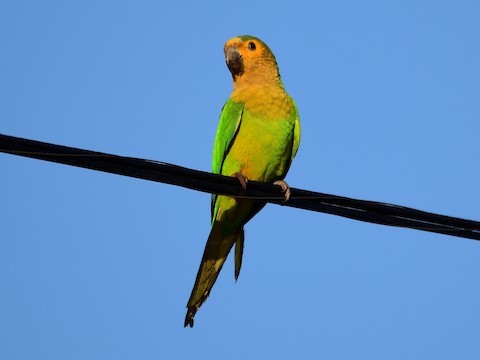
Some individuals in the Aruba population of Brown-throated Parakeet (arubensis), such as this one, have extensively orange heads. © Michael Tromp
“Gray-throated Parakeet”. The subspecies aeruginosa, of northern and central Colombia, differs from other Brown-throated populations in having no orange on its face. It therefore resembles the immature plumages of other subspecies, which begin with grayish-green faces and whitish eyerings. As adults, the other subspecies’ facial feathers turn browner, except for the feathers around their eyes, which turn orange. A similar progression occurs in aeruginosa, except that its facial feathers turn grayer and—unique among Brown-throated populations—it lacks orange feathers around its eyes. Compared to the rest, “Gray-throated” shows a more distinctly bluish forecrown.
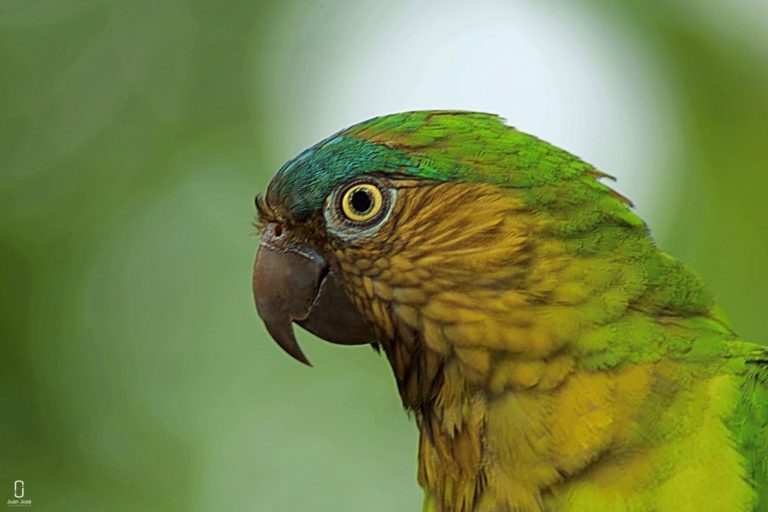
“Gray-throated Parakeet” (aeruginosa) showing “scaly”-textured, olive or yellowish-brown face, throat, and chest, pale-bluish eyering, and turquoise crown. © Juan José López Negrete
If aeruginosa is recognized as a distinct form, the name “Gray-throated Parakeet” seems appropriate as this would signal one of its most distinctive features and it would fit the pattern of two well-established Eupsittula names: Brown-throated and Olive-throated.
Note that a second Colombian endemic subspecies, griseipecta, has been assigned to a population that reputedly inhabits the Río Sinú valley and differs in having a pale-gray forehead. This may have been in error, however, as birds of the Río Sinú valley are not readily distinguishable from aeruginosa, and immature plumages of other Brown-throated populations can show pale-gray foreheads.

“Gray-throated Parakeet” (aeruginosa) with a pale grayish face and forehead—likely an immature. (Santuario de Fauna y Flora Los Flamencos, La Guajira, Colombia; July 30, 2017.) © Eric VanderWerf
“Veraguan Parakeet”. The subspecies ocularis, of the Pacific lowlands of Costa Rica and Panama, has sometimes been proposed for recognition as a separate species. It closely resembles typical “Brown-throated” populations in head coloration, but consistently shows a specific pattern: the face is grayish-brown with a strong orange crescent below the eye—sometimes extending farther down onto the cheek and behind the eye.
Some of the more distant “Brown-throated” populations—those of the Guianas and Amazonian Brazil—resemble ocularis, but they tend to show a complete orange eyering rather than an orange crescent below and behind the eye.
Based on biogeographical logic, the taxonomic status of ocularis seems tied to that of aeruginosa, which is wedged between ocularis and all the other Brown-throated populations. The natural—but perhaps false—presumption is that the adjacent populations are likely to share more recent ancestry and therefore be closer relatives. If the adjacent and different-looking “Gray-throated” is recognized as a distinct form or species, then it seems likely that the more distant and similar-looking “Veraguan” should be equally distinct.
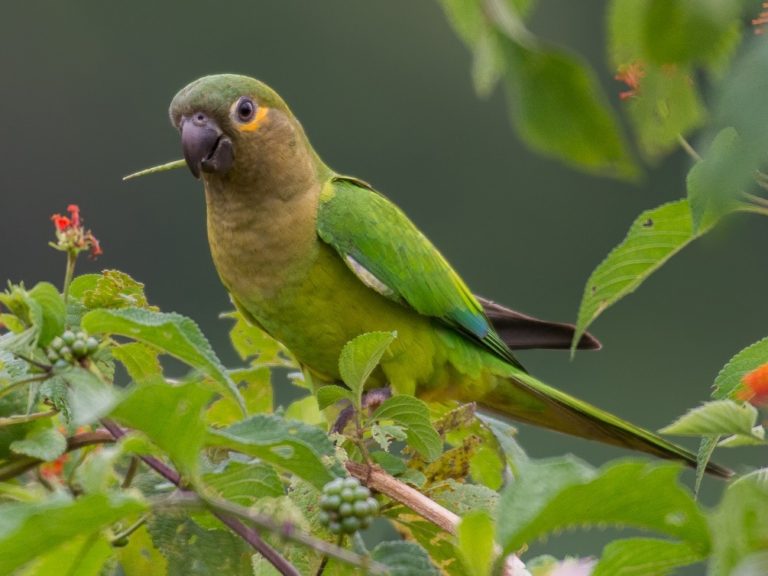
The “Veraguan Parakeet” (ocularis) most closely resembles the most distant populations of the “Brown-throated” form, with a subtle but consistent difference in its facial pattern: an orange crescent under the eye instead of a complete eyering. © Daniel Hernández
“Brown-throated Parakeet”. Adults of the remaining nine subspecies (arubensis, chrysophrys, chrysogenys, lehmanni, margaritensis, paraensis, surinama, tortugensis, and venezuelae) appear to share approximately the same pattern and coloration on the head. The extent and intensity of orange vary, but apparently along a spectrum—with mostly duller-colored populations in Venezuela (including Isla Margarita) and the Colombian Llanos and brighter-colored populations in the Guianas and Brazil, and on Aruba.
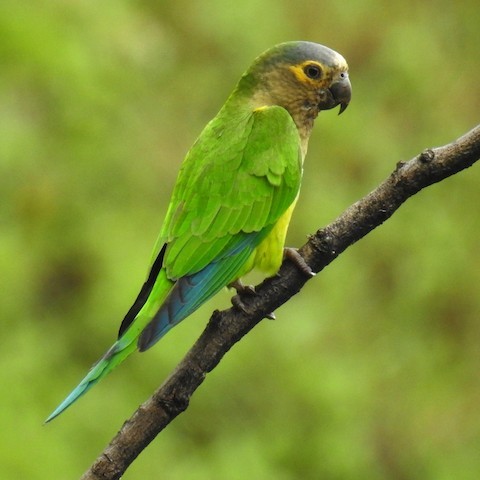
Venezuelan populations of Brown-throated Parakeet, such as this venezuelae photographed at El Ávila National Park, are generally duller-plumaged than other populations. © Fernando Nunes

The easternmost populations of Brown-throated Parakeet, such as these surinama photographed in Trinidad, are generally brighter-plumaged than other populations. © Patsy Russo
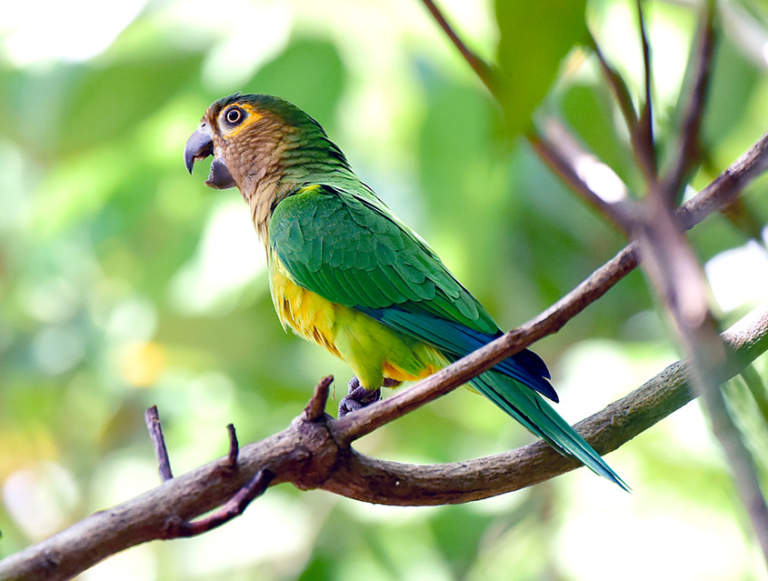
When the three localized forms are subdivided, the remaining “Brown-throated” form is chrysophrys—such as this individual photographed in Boa Vista, Roraima, Brazil. © Jorge Macêdo
References
Ascanio, D., G.A. Rodriguez, and R. Restall. 2017. Birds of Venezuela. Christopher Helm, London.
BirdLife International. 2018. Eupsittula pertinax. The IUCN Red List of Threatened Species 2018: e.T22685745A131917543. https://dx.doi.org/10.2305/IUCN.UK.2018-2.RLTS.T22685745A131917543.en. (Accessed November 19, 2021.)
eBird. 2021. eBird: An online database of bird distribution and abundance. Cornell Lab of Ornithology, Ithaca, N.Y. http://www.ebird.org. (Accessed November 19, 2021.)
Forshaw, J.M. 2010. Parrots of the World. Princeton University Press, Princeton, N.J.
Juniper, T., and M. Parr. 1998. Parrots: A Guide to Parrots of the World. Yale University Press.
McMullan, M., and T. Donegan. 2014. Field Guide to the Birds of Colombia (Second Edition). Fundación Proaves de Colombia. Bogotá.
van Perlo, B. 2009. A Field Guide to the Birds of Brazil. Oxford University Press.
WikiAves. 2021. Periquito-de-bochecha-parda. http://www.wikiaves.com.br/wiki/periquito-de-bochecha-parda. (Accessed November 19, 2021.)
Wells, J.V., and A.C. Wells. 2017. Birds of Aruba, Bonaire, and Curaçao. Cornell University Press.
Xeno-Canto. 2021. Brown-throated Parakeet – Eupsittula pertinax. https://www.xeno-canto.org/species/Eupsittula-pertinax. (Accessed November 19, 2021.)
Text © Russell Fraker / November 23, 2021